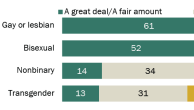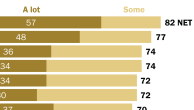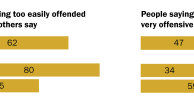by Anthony G. Greenwald, professor of psychology, University of Washington and Bethany Albertson, assistant professor of political science, University of Washington
As this year’s primaries and caucuses have progresssed, we have been analyzing polling data to see if race still plays a role in American politics. Our research suggests that race is, indeed, still a significant factor in determining electoral outcomes, but that it showed up in surprising ways in tallies from some of the states holding Democratic primary elections so far this year (see discussion below). The results of last Tuesday’s Indiana and North Carolina open primaries provide further evidence of the effects we observed earlier.
The discrepancy between pre-election polls in North Carolina and the actual vote was, given the relative size of the state’s black population, almost exactly as we had predicted from the previously observed discrepancies between pre-election polls and actual vote outcomes.
Indiana, however, deviated slightly from what our observations of earlier primaries suggested: Clinton received about 7% fewer votes than the analysis had predicted. In other words, strictly on the basis of Indiana’s heavily white population, Clinton’s margin of victory should have been significantly larger than the two percentage points actually recorded and larger even than the 5-point margin that pre-election polls predicted on average.
Earlier Analysis
The so-called “Bradley effect” was first noticed by survey researchers in 1982 when black Los Angeles Mayor Tom Bradley had a solid lead in the pre-election gubernatorial polls, but lost a close election in California to his Republican opponent. Results from that and other races involving black candidates indicated that, for whatever reason, pre-election polling tended to overstate support for black candidates compared with their actual vote percentages.
Throughout this year’s primary season, we have been comparing data from pre-election polls with actual voting patterns as revealed in exit polls to see if the Bradley effect is still operative. In research we jointly undertook last December, we analyzed data from an online test that measures unconscious or automatic preferences2. On the basis of our findings, we surmised that the Bradley effect might well repeat itself in 2008. Our more recent findings, however, suggest a more complicated pattern.
Analysis of primary counts and polling data from the early primaries, including those held before and on Super Tuesday (February 5), indicated that pre-election polls did indeed exaggerate support for Sen. Barack Obama in three states with relatively low black populations — New Hampshire, California and Massachusetts. But the reverse was true in South Carolina, Alabama and Georgia, where blacks make up a larger bloc of voters.
As shown in the graph, the findings in South Carolina, Alabama and Georgia suggested to us the discovery of a new “reverse” Bradley effect, i.e., that in states with relatively large African American populations, pre-primary polls tended to underestimate support for Obama. (View a larger version of the graph)

The strength of these two effects is shown in the fact that the differences between the actual results of the Democratic primaries in California, Massachusetts, New Hampshire, South Carolina, Georgia and Alabama as well as the polling numbers from three subsequent Democratic open primaries substantially exceeded the polls’ expected margin of error, being off by between 8 and 18 percentage points. By contrast, we found that Republican vote totals and poll numbers were off substantially only in Massachusetts where Mitt Romney’s winning margin was less than predicted.
The February 19 results in Wisconsin — where the black population is relatively small but pre-primary polls significantly underpredicted Obama’s large win — did provide a strong exception by presenting a “reverse Bradley” effect in a state with low black population. Results of the subsequent March 4 primaries, however, suggest that Wisconsin was a one-time outlier or that the phenomenon observed there was transitory.
The Bradley effect was strongly evident again in Rhode Island, with its relatively small black population, where pre-election polls underestimated the Clinton-Obama vote gap by more than 8 percentage points. The outcomes in Ohio and Texas were approximately in line with expectations although in both states Obama’s vote was over-predicted slightly. In retrospect then it appears that Obama’s success in Wisconsin did not mean that the dynamics of race had fundamentally changed by that point in the primary season.
In Mississippi, with its large black population (36%), the results again showed a reverse Bradley effect. It’s nevertheless interesting that the “MS” point as shown in the graph, is noticeably above the regression line, although it is far less of an outlier than Wisconsin. Moreover, despite a 24-point loss in the popular vote, Clinton in a sense did “better than expected,” when one generates the expectation from the combination of regression plot and pre-election polls.
It is evident from the substantial deviations shown in the graph — with the Obama-Clinton gap off by more than 8 percentage points in 9 of 18 open primaries — not only that race is still strongly operative as a factor in America’s state elections, but also that its impact depends in substantial part on the racial mixture of the state in question.
Notes
1Earlier version of this analysis were posted on pewresearch.org on Feb. 7, 2008, March 5, 2008 and March 14, 2008.
2More information on the study of hidden biases can be found at the Project Implicit website.




